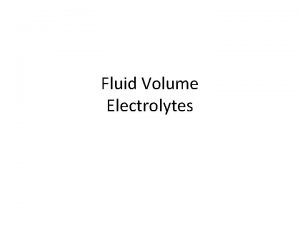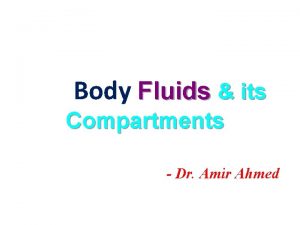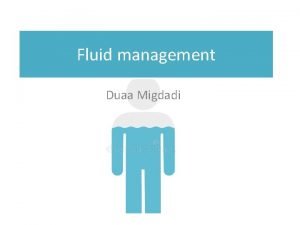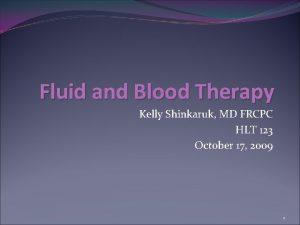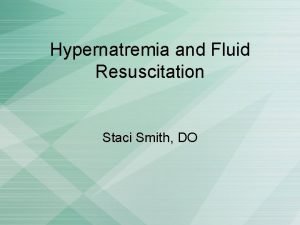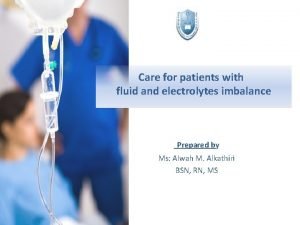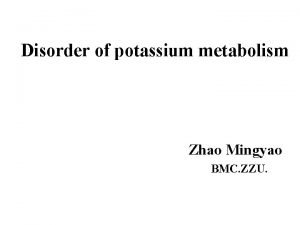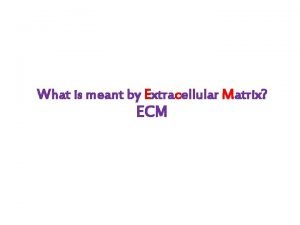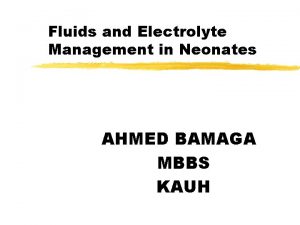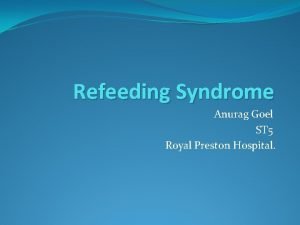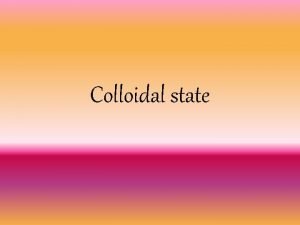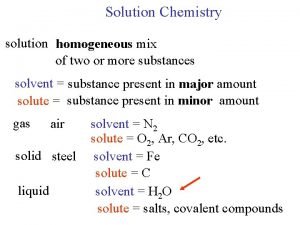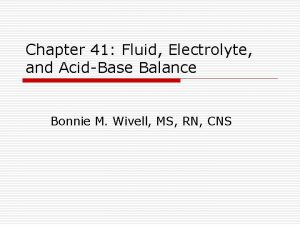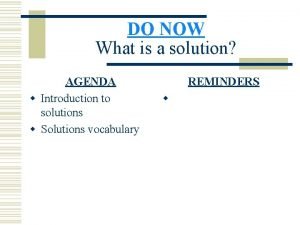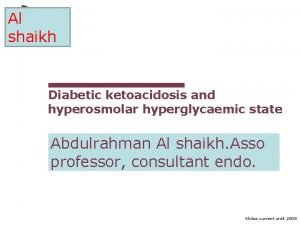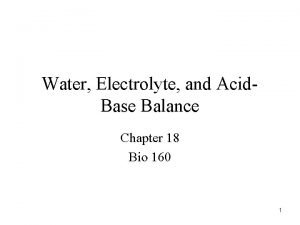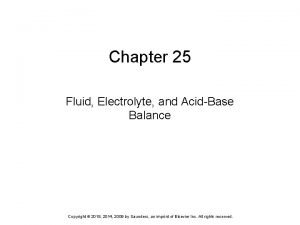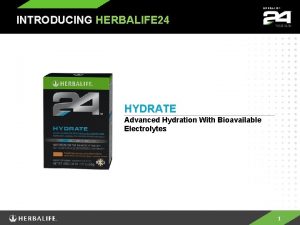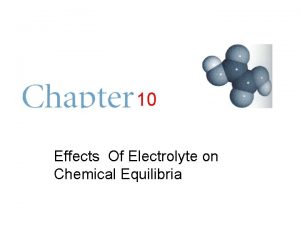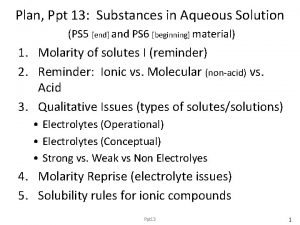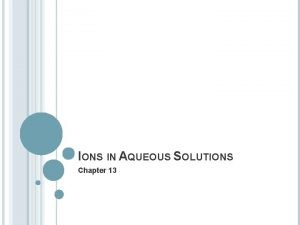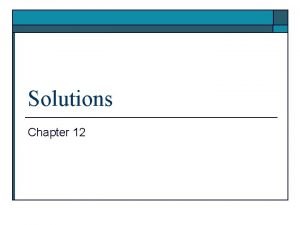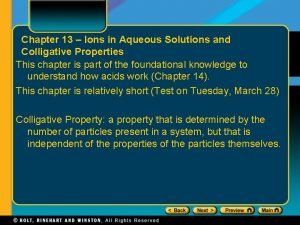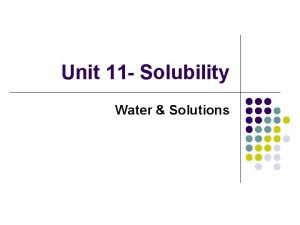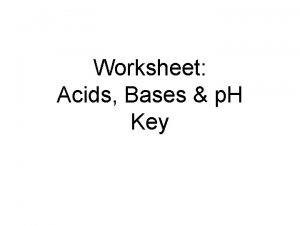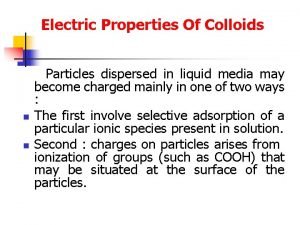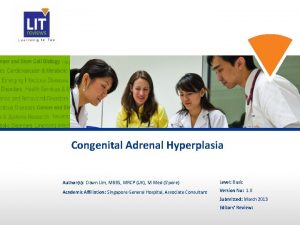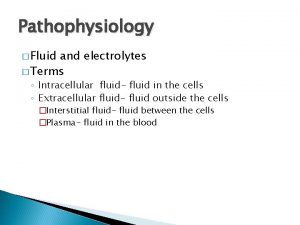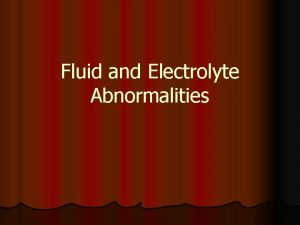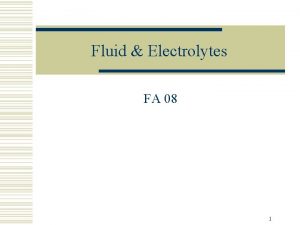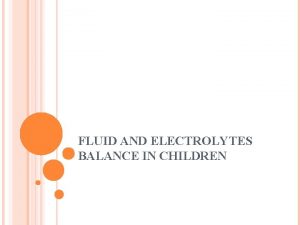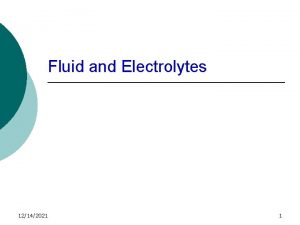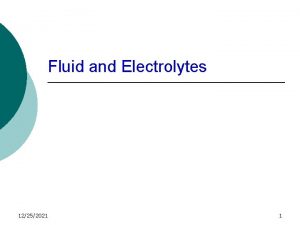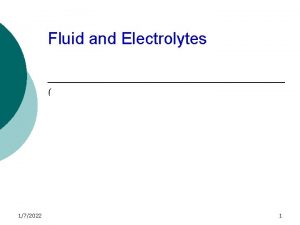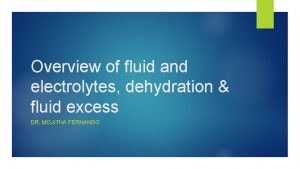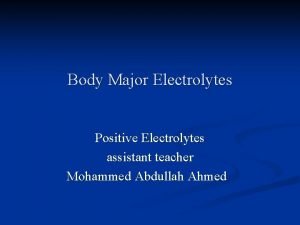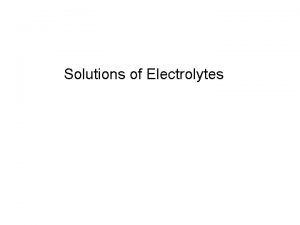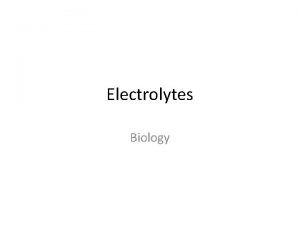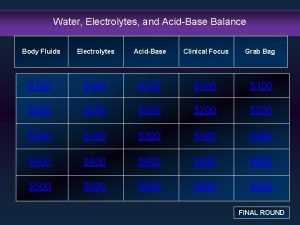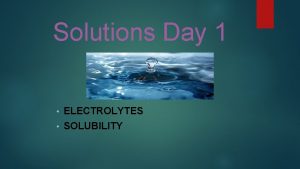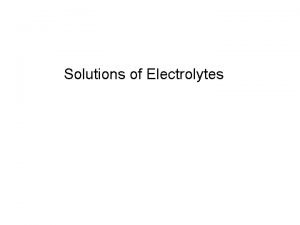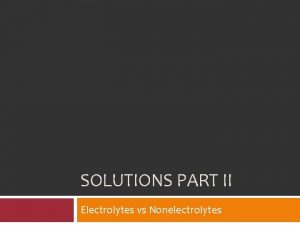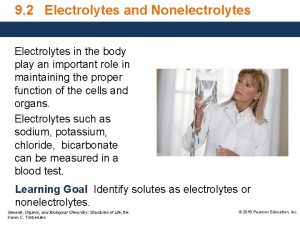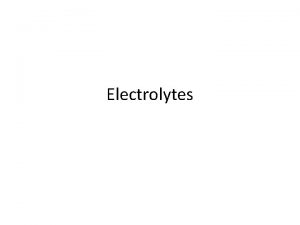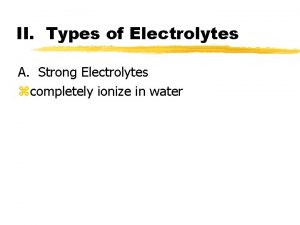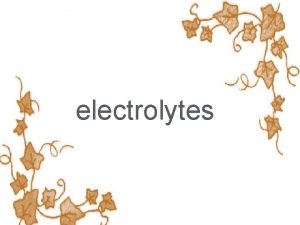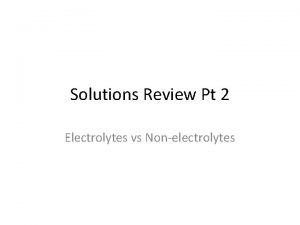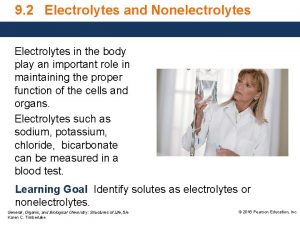Fluid Volume Electrolytes Causes ECF Volume deficit Hypovolemia








































- Slides: 40

Fluid Volume Electrolytes

�Causes ECF Volume deficit Hypovolemia �Abnormal fluid loss �Diarrhea �Fistula drainage �Hemorrhage �Polyuria �Fever (↑ perspiration) �Inadequate intake �Osmotic diuresis 2

ECF Volume Deficit: Hypovolemia Cardiovascular Changes Respiratory Changes Mild to moderate o ↑ respiratory rate o ↑ HR o Peripheral pulses are weak, difficult to find o Change in position may cause ↑ HR or ↓ BP o Dizziness and light -headedness Severe fluid volume o ↓ BP in lying position o Pulse: weak, thready o Flattened neck veins Renal Changes Neurologic Changes o UO below 500 m. L/day Alteration in Mental Status o Restlessness o Drowsiness o Lethargy o Confusion (more common in the elderly; may be first indicator of fluid balance problem) o Seizures, coma 3

ECF Volume deficit Assessment Findings �Skin turgor is diminished �Skin may be warm and dry with mild deficit �Skin may be cool and moist with severe deficit �Skin may appear dry and wrinkled �Oral mucous membranes will be dry, sticky, pastelike coating and the tongue may be furrowed �Patient C/O thirst �Eyes: soft, sunken �Lab data: �↑ H & H; BUN; Josie King 4

Nursing Care Plan Therapeutic Interventions �Restore fluid and electrolyte balance �IVs and blood products as ordered; small, frequent drinks by mouth �Daily weights to monitor progress of fluid replacement �Loss or gain of 2. 2 lbs is equal to 1 L of fluid �I & O, hourly outputs �Two most important assessments: HR & Output �Avoid hypertonic solutions �Promote comfort �Frequent skin care �Position: change q hr to relieve pressure �meds as ordered: antiemetics, antidiarrheal 5

Nursing Care Plan Therapeutic Interventions �Prevent physical injury �Risk for falls due to orthostatic hypotension, dysrhythmia, muscle weakness, gait stability and level of alertness. �Frequent mouth care �Dry mucous membrane due to dehydration �Monitor IV flow rate �Observe for circulatory overload (↑ pulse, ↑ HR) �Pulmonary edema (SOB) �Monitor vital signs �BP should be rising, ↑ LOC: more alert 6

ECF Volume excess Hypervolemia • Causes – Excessive intake of fluids – Abnormal retention of fluids • Heart failure • Renal failure – Long-term corticosteroid therapy 7

ECF Volume Excess: Hypervolemia Cardiovascular Changes Respiratory Changes Skin Changes Neurologic Changes Other Changes o ↑ Pulse: full and bounding o Full peripheral pulses o Distended neck veins o ↑ BP o ↑ respiratory rate o Shallow respirations o ↑ dyspnea with exertion or in the supine position o Pulmonary congestion and pulmonary edema o SOB o Irritative cough o Moist crackles o Edematous may feel cool o Skin may feel taut and hard o Edemaeyelids, facial, dependent (sacrum), pitting, peripheral extremities o Altered LOC o Visual disturbances o Skeletal muscle weakness o Parenthesis o Cerebral edema o Headache o Confusion o Lethargy o Diminishe d reflexes o Seizures, coma o Urine: polyuria, nocturia o Lab data ↓Hematocrit, BUN GI Changes o Increased motility o Enlarged liver 8

Nursing Care Plan Therapeutic Interventions �Maintain oxygen to all cells �Position: sim-Fowler’s or Fowler’s to facilitate improved gas exchange. �Vital signs; q 4 hrs and PRN �Tachycardia �↑ BP (overload) and ↓ BP (fluid deficit) �Fluid restriction: I & O �Promote excretion of excess fluid �Meds as ordered: diuretics �Monitor electrolytes, esp. Mg and K 9

Nursing Care Plan Therapeutic Interventions �Obtain/maintain fluid balance �Wt gain is the best indicator of fluid retention and overload �Weight daily; 2. 2 lbs = 1 Liter (1000 ml) �Measure: all edematous parts, abdominal girth, �I & O: fluid restriction �Limit fluids by mouth, IVs per doctors orders �Strict monitoring of IV fluids �Prevent tissue injury �Skin and mouth care as needed �Evaluate feet for edema and discoloration when client is OOB �Observe suture line on surgical clients (Potential for evisceration due to excess fluid retention) 10

Functions of Sodium • Regulates osmolality – ICF: 14 mmol/L & ECF: 135 -145 mmol/L • Helps maintain blood pressure by balancing the volume of water in the body • Works with other electrolytes to promote nerves, muscles and other body tissues to work properly. 11

Hypernatremia Na Excess H 2 0 ↑ Osmolality Normal ECF/↑ ECF Water Deficiency H 2 0 ↑ Osmolality ↓ ECF (Looks like excessive Na) 12

Hypernatremia Water loss: Causes Water loss: Signs and Symptoms � Inadequate water intake (dehydration) • Restlessness, agitation, twitching, confusion • Seizures*, Coma • Intense thirst • Dry, swollen tongue • Sticky mucous membranes • Weight loss • Weakness, lethargy • Postural hypotension � Unconscious or cognitively impaired individuals � NPO status � Excessive water loss � ↑ insensible water loss � High fever � Diuretic therapy � Watery diarrhea � Disease states � Kidney � Uncontrolled diabetes mellitus � Diabetes insipidus 13

Hypernatremia Na gain: Causes Na gain: Signs and Symptoms �Na intake • Restlessness, agitation, twitching • Seizures, Coma • Intense thirst • Flushed skin • Weight gain • Peripheral and pulmonary edema • ↑ BP �IV fluids: hypertonic Na. Cl, excessive isotonic Na. Cl �Hypertonic tube feeding with out water supplement �Use of Na containing drugs �Corticosteroids �Diseases � Renal failure 14

Group learning • Discuss with your neighbor – Why in Hypernatremia (water deficit) and hypernatremia (gain of more salt) there is a difference in the BP (blood pressure). – List a Nursing Diagnosis for a patient with hypernatremia. 15

Hyponatremia Na deficiency (Loss of Na containing fluids) H 20 ↓ ECF Volume Excess Na Loss Water Excess (↑ ECF Volume) H 2 0 ↓ Osmolality ↑ ECF Dilutional 16

Hyponatremia • Dilutional (↑ ECF Volume) Causes – Use of hypotonic irrigation solution – Tap water enemas – Excessive water gain • Excessive hypotonic IV fluid �Dilutional (↑ ECF Volume) Signs and Symptoms �Headache, apathy, confusion �Nausea, vomiting, anorexia � Lethargy � Weakness �Muscle spasms, seizures, coma �Diarrhea, Abdominal cramps �Weight gain �↑ BP 17

Hyponatremia �Na Loss: Causes �GI �Vomiting �Diarrhea �NG suctioning �NPO Status �Kidney �Diuretic �Skin • Burns • Wounds • Excessive diaphoresis �Na Loss: Signs and Symptoms �Irritability, apprehension, confusion �Dizziness �Personality changes � Tremors, seizures, coma � Dry mucous membranes � Postural hypotension �Tachycardia, thread pulse � Cold & clammy skin � 18

Functions of Potassium • Maintains fluid balance in the cells – Contributes to intracellular osmotic pressure • Direct effect on excitability of nerves and muscles – Skeletal, cardiac, and smooth muscle contraction • Regulates glucose use and storage 19

Hyperkalemia Causes • Most cases of hyperkalemia occur in hospitalized patients and in those undergoing medical treatment. • Those at greatest risk for hyperkalemia are – Chronically ill patients – Debilitated patients – Older adult 20

Hyperkalemia Causes Actual hyperkalemia Relative hyperkalemia • Excess potassium Intake • Shift of potassium Out of Cells – Excessive or rapid parenteral administration – Acidosis – Crushing injury – Tissue catabolism (fever, sepsis, burns) 21

Hyperkalemia Causes • Failure to Eliminate Potassium – Renal disease – Potassium-sparing diuretics – ACE inhibitors 22

Hyperkalemia Signs and Symptoms Clinical Manifestations Electrocardiogram Changes �Irritability �Abdominal cramping, diarrhea �Weakness of lower extremities �Irregular pulse �Cardiac arrest if hyperkalemia sudden or severe • Ventricular fibrillation • Ventricular standstill 23

Hypokalemia Causes • Potassium Loss – GI losses: diarrhea, vomiting, fistulas, NG suction, NPO status – Renal losses: diuretics, – Skin losses: diaphoresis – Dialysis • Shift of Potassium into Cells – Alkalosis 24

Hypokalemia Causes • Lack of Potassium Intake – Starvation – Diet low in K – Failure to include K in parenteral fluids if NPO – TPN 25

Hypokalemia Signs and Symptoms Clinical Manifestations Electrocardiogram Changes �Fatigue �Muscle weakness, leg cramps �Nausea, vomiting, paralytic ileus �Soft, flabby muscles �Paresthesia, decreased reflexes �Weak, irregular pulse • Ventricular dysrhythmias (e. g. , PVCs) • Bradycardia 26

Hypokalemia Medical Management �Administration of KCl supplements �K may be given orally (K chloride, K gluconate, K citrate) or IV �KCl should be administered IV at a rate of 10 to 20 m. Eq/L over an hour. Rapid infusion could cause cardiac arrest �IV K solutions irritate veins and cause phlebitis. Check IV site q 2 hrs. Discontinue IV if infiltrate to prevent necrotic and slough of tissue 27

Functions of Calcium • Helps maintain muscle tone • Contributes to regulation of blood pressure by maintaining cardiac contractility • Necessary for nerve transmission and contraction of skeletal and cardiac muscle 28

Hypercalcemia Causes �Increased Total Calcium �Prolonged immobilization �Thiazide diuretics �Dehydration �Renal failure 29

Hypercalcemia Signs and Symptoms Clinical Manifestations Electrocardiogram Changes �Lethargy, weakness �Depressed reflexes (DTR) �Decreased memory �Confusion, personality changes, psychosis �Anorexia, nausea, vomiting, constipation �Bone pain, fractures • Ventricular dysrhythmias • Hypertension 30

Hypocalcemia Causes �Decreased Total Calcium �Chronic renal failure �Loop diuretics (e. g. , furosemide [Lasix]) �Chronic alcoholism �Diarrhea �Decreased Ionized Calcium �Excess administration of citrated blood 31

Hypocalcemia Signs and Symptoms Clinical Manifestations Electrocardiogram Changes �Easy fatigability �Depression, anxiety, confusion �Numbness and tingling in extremities and region around mouth • Hyperreflexia, muscle cramps • Chvostek’s sign & Trousseau’s sign • Laryngeal spasm • Tetany, seizures • Ventricular tachycardia 32

Functions of Magnesium • Cofactor in clotting cascade • Acts directly on myoneural junction, affecting muscular irritability and contractions • Maintains strong and healthy bones 33

Hypermagnesemia Causes �Renal failure �Diabetes Mellitus �Clients who ingest large amounts of Mgcontaining antacids such as Tums, Maalox, Mylanta, or laxatives such as MOM are also in ↑ risk for developing hypermagnesemia 34

Hypermagnesemia Signs and Symptoms – Bradycardia and hypotension – Severe hypermagnesemia: cardiac arrest – Drowsy or lethargic – Coma – Deep tendon reflexes are reduced or absent – Skeletal muscle contractions become progressively weaker and finally stop 35

Hypomagnesaemia Causes • Malabsorption disorders – Inflammatory bowel disease (IBD) – Bowel resection – Bariatric population who undergoes gastric bypass surgery • Alcoholism • Prolonged diarrhea • Draining GI fistulas • Diuretics 36

Hypomagnesaemia Signs and Symptoms • Confusion • Hyperactive deep tendon reflexes • Tremors • Seizures • Neuromuscular changes – Hyperactive deep tendon reflexes – Numbness and tingling – Painful muscle contractions – Monitor for positive Chvostek’s and Trousseau’s signs (hypocalemia may 37

Group learning • Discuss with your neighbor – The questions the nurse asks to elicit risk factors for fluid and electrolyte imbalances – How recent surgery causes changes in F & E imbalances – How increased GI output can cause changes in F & E imbalances 38

Physical Assessment • Daily weights – Indicator of fluid status – Use same conditions. • Fluid intake and output (I&O) – 24 -hour I&O: compare intake versus output – Intake includes all liquids eaten, drunk, or received through IV. – Output = Urine, diarrhea, vomitus, gastric suction, wound drainage • Laboratory studies

Fluid and Electrolyte Assessment • Nutritional-Metabolic Pattern – What is your typical daily food intake? Describe a day’s meals, snacks, and vitamins. – How much salt do you typically add to your food? Do you use salt substitutes? – How is your appetite? – Do you have any difficulty chewing or swallowing? – What is your typical daily fluid intake? What types of fluids (water, juices, soft drinks, coffee, tea)? How much? 40
 Ecf volume deficit
Ecf volume deficit Ecf icf and interstitial fluid
Ecf icf and interstitial fluid Ecf icf and interstitial fluid
Ecf icf and interstitial fluid Fluid deficit calculation
Fluid deficit calculation Water deficit formula
Water deficit formula 4 2 1 rule
4 2 1 rule Potassium replacement
Potassium replacement Neurocirkulačná asténia
Neurocirkulačná asténia Fwd mdcalc
Fwd mdcalc H2ra vs ppi
H2ra vs ppi Transportec
Transportec Hypovolémia
Hypovolémia Ecf
Ecf Icf and ecf
Icf and ecf Extracellular
Extracellular Ecf wsfcs
Ecf wsfcs Write the function of ecf in the sdlc frame structure.
Write the function of ecf in the sdlc frame structure. Major intra and extracellular electrolytes
Major intra and extracellular electrolytes Is sucrose soluble in water
Is sucrose soluble in water Whats refeeding syndrome
Whats refeeding syndrome Colloidal matter meaning
Colloidal matter meaning Weak electrolytes
Weak electrolytes Electrolytes normal range
Electrolytes normal range Electrolytes and nonelectrolytes
Electrolytes and nonelectrolytes Diabetic ketoacidosis
Diabetic ketoacidosis Pn
Pn Chapter 18 fluids and electrolytes
Chapter 18 fluids and electrolytes Normal electrolytes values
Normal electrolytes values 24 hydrate
24 hydrate How does electrolytes affect the chemical equilibria
How does electrolytes affect the chemical equilibria Electrolytes ppt
Electrolytes ppt Strong vs weak electrolytes
Strong vs weak electrolytes Negative deviation from raoult's law
Negative deviation from raoult's law Strong vs weak electrolytes
Strong vs weak electrolytes Solubility curve
Solubility curve Vacid definition
Vacid definition Effect of electrolytes on colloidal dispersion
Effect of electrolytes on colloidal dispersion Non classical adrenal hyperplasia
Non classical adrenal hyperplasia Interstitial fluid vs extracellular fluid
Interstitial fluid vs extracellular fluid Turbid ascites
Turbid ascites Fluid statics deals with fluid at rest
Fluid statics deals with fluid at rest
